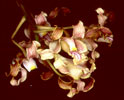|
|
|
|
|
| |
Flasks of
Dendrobium pseudoconanthum 'SUL359' -spontaneous |
|
| |
|
|
| |
| Number: |
TN4598 |
| Name: |
Dendrobium pseudoconanthum 'SUL359' -spontaneous
|
| Type: |
spontaneous (What's that?) |
|
Click to Enlarge

Pod Parent Flowers |
|
|
|
| |
Culture Notes from Donor: Parent plant: W (70-90°F); Dendrobium pseudoconanthum is found in grassland regions of Sulawesi, where it grows on exposed solitary trees and (less commonly) on emergent trees in riverine forest. The climate is: heavy rain during the monsoon, which normally starts in October/November and ends in March or April, and mostly dry for the rest of the year, with light rain once or twice a fortnight and mist or dew on 2-3 mornings per week. Temperatures during the dry season: the early-morning low is usually about 20°C, rarely as low as 17°C, and the mid-afternoon maximum is usually around 32°C, rarely reaching 36°C. Temperatures during the monsoon would be several degrees cooler. Humidity is high in early morning but drops rapidly during the day. Light levels are extremely high and the plants receive full sun or only the slightest possible shade. These grasslands are windy, with a warm breeze blowing constantly during the day.
Comments: Parent plant: Dendrobium pseudoconanthum is one of the least known "antelope dendrobiums" (Section Spatulata). It has never been in general cultivation, and had never been photographed prior to July 2004. Plants are similar in habit to other antelope dendrobiums; stems are very large (up to 230 cm long) but the base is not particularly swollen. Stem colour is almost black. Each stem produces up to 9 inflorescences. Inflorescences reach up to 37 cm long with up to 15 flowers. Very large plant.
For additional origin/habitat information supplied courtesy of
Charles and Margaret Baker, see further below, near the bottom of this page.
|
Temperatures we attempt to use in the lab & greenhouse:
| For Species: |
|
Spring, Summer, Autumn, Winter: days average 87°F, nights 73°F; best fit is Warm 90-70°F
(Source:
Baker's Web OSC) |
|
About the name...
| Etymology of |
Dendrobium |
|
From Greek "dendron" tree and "bios" life.
(Source:
Pridgeon 1992) |
| Etymology of |
pseudoconanthum |
|
From latinized Greek "pseudo-" like. Almost like the species Dendrobium conanthum... latinized Greek "conanthus" standing tightly.
(Source:
Mayr & Schmucker 1998) |
| Pronunciation of |
Dendrobium |
|
den-DRO-bee-um
(Source:
Pridgeon 1992) |
|
If you would like to direct someone to this web page, please copy and paste this URL into your email:
http://troymeyers.com/d?014598
| Flask Information |
| Availability: |
We have sold all of the flasks for this item. |
| You should: |
Consider getting individual plants or compots instead of a flask.
You can place a "Notify Flask Recipients" Request, and either we or a flask recipient may contact you when plants are available.
You may also place a "Notify Retries" Request, and if an identical pollination (the same parents) is done again, we'll let you know.
You may reserve a flask, but it's very unlikely you'll get one ...this could only happen if we found a flask that we didn't know we had. |
| Yield Estimate: |
500 plants (based on flask surveys done 01/06/2005 through 08/10/2006)
|
| Plantlet Sizes: |
From many flasks 5 - 70 mm plants (based on flask surveys done 12/27/2004 through 08/10/2006)
From one most recently surveyed flask 10 - 50 mm (08/10/2006)
|
|
You might also want to:
|
View the seed assay for this item.
View items of the same species.
View items of the same genus.
|
| Ordering Information |
| You are not currently logged in. |
|
You must be a registered user and be logged in to reserve a flask or place a notification request. Please log in:
|
|
|
|
|
|
| |
The origin/habitat information below is supplied courtesy of Charles and Margaret Baker
The following information is based on the name of the plant provided by the donor, and assumes that the name is correct. If the plant has been misidentified, then the following information may not be correct.
This text is copyrighted by the Bakers and may not be reproduced without permission.
ORIGIN/HABITAT: Endemic to southern Sulawesi (Celebes) Island. Plants have
been collected at Bone, near Pampanoea.
More about this information and the Bakers...
|
|
|
| |
|
|
|